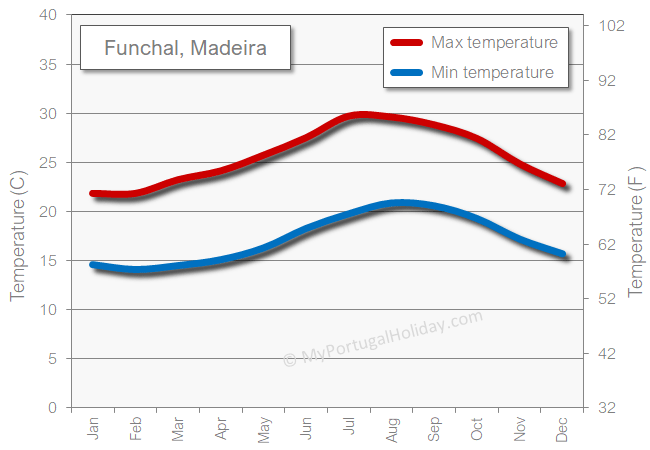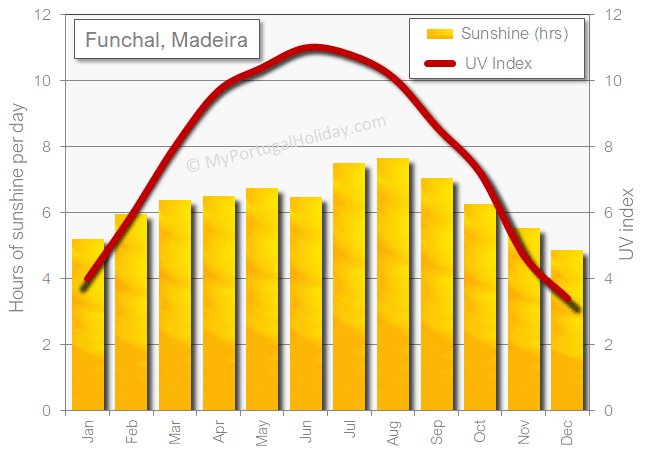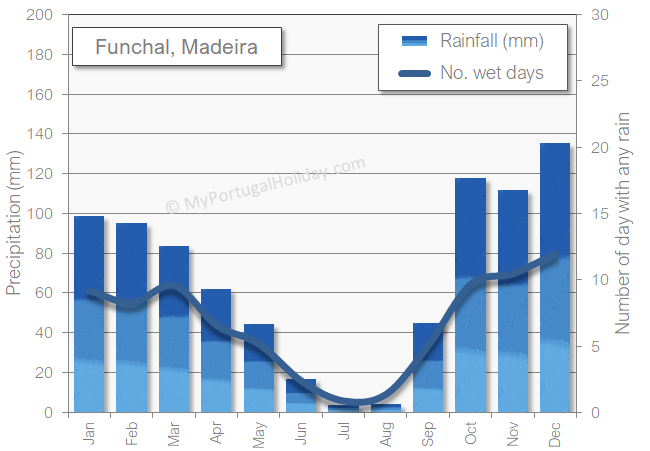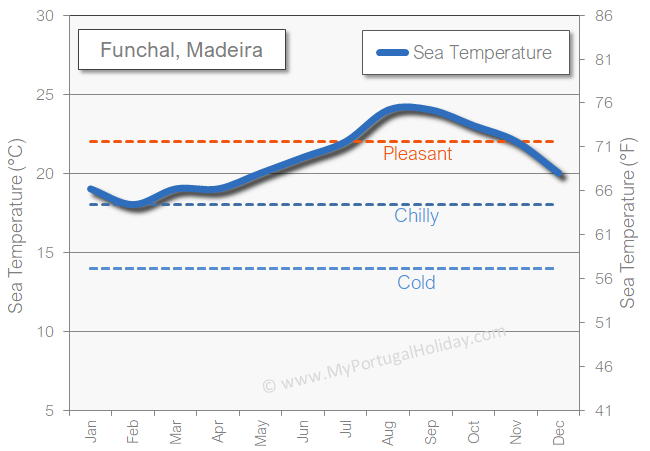MyPortugalHoliday.com
The best independent guide to Madeira
MyPortugalHoliday.com
The best independent guide to Madeira
When to visit Madeira and the weather
Madeira is often referred to as "the island of eternal spring" and this is the best way to describe the island's varied weather.
The island sits in the middle of the Atlantic Ocean and the Gulf Stream, nullifying any extreme seasonal temperatures, while the prevailing winds and high mountains ensure rain falls throughout the year. Considering that Madeira is on the same latitude as Morocco, the weather is much less intensely hot during the summer, reaching a pleasant average of 26°C in August.
There are two distinct seasons in Madeira: a slightly cooler and wetter winter (October to April) and a drier and warmer summer (May to September), but the location on the island has just as much an effect on the weather as the time of year.
The majority of the rain falls on the interior mountains or the rugged northern coastline, while the east and south (including the main city of Funchal) are significantly drier. The eastern side, close to the airport, may be drier but is often exposed to strong winds.
Just by simply crossing the island, you can leave hot sun in Ribeira Brava, pass through cold mountain fog at Serra de Água, and get drenched by an intense rainstorm at São Vicente. This variable weather causes locals to joke "that you can experience all four seasons just by travelling around the island".
In summary, Madeira boasts great weather during the summer months, with June being a slight exception. Even in winter, when conditions can be cloudy and wet, the island's climate remains significantly more pleasant than that of mainland Europe.
Related articles: Introduction to Madeira – Madeira top 10 - 1 week in Madeira
A brief summary of when to visit Madeira Note for June:
January to March - (Low season) – An equal number of bright sunny days and grey days, with the potential for heavy rain, especially in the mountainous areas.
4 weeks after Easter – The Flower Festival, the whole of Funchal is decorated with flowers and the island is full of colour (a great time to visit).
June – Generally dry and warm, but prone to persistent cloud cover, often called "June gloom".
July-September (High season) –Peak visitor season with warm, dry weather - the best season for a traditional summer holiday.
October-December (Medium season) - Increased cloud cover and chance of rain, but still warm, sunny spells. Popular with travellers escaping the harsher European winters.
Note for June: The typical weather for June is dense cloud cover, but this varies from year to year. If you come expecting full sun and sunbathing weather (like the rest of Portugal) you will be disappointed, but if you come for a sightseeing holiday you will have a great time.
Average weather charts for Madeira




Note: These weather charts are the average weather for Funchal, where the majority of tourists are based during their holiday. The north and west regions will always be slightly wetter and cooler.
When is the best time of year to visit Madeira?
Madeira's mild climate makes it a year-round destination, but the best time to visit depends on your preferences.
The peak season, from July to September, offers the warmest and driest weather, with temperatures reaching a pleasant maximum of 26°C in August. Unlike much of southern Europe (Rome averages 31°C and Madrid 32°C), Madeira remains comfortably warm. However, this period sees more tourists and higher prices for accommodation and flights.
For a balance of good weather and fewer crowds, consider visiting from April to June or October to November. Spring brings the colorful Flower Festival, lasting four weeks after Easter and culminating in a vibrant carnival. These shoulder seasons are ideal for outdoor activities and hiking.
If you prefer fewer crowds and lower prices, October to November is an excellent choice. Ultimately, Madeira offers diverse experiences year-round, from beach weather in summer to unique winter landscapes and holiday celebrations.
Madeira in the winter
Winter in Madeira offers a unique experience for visitors seeking a milder climate without the intense heat of traditional sun destinations. From December to February, the island maintains a relatively stable temperature, with daytime averages hovering around 16-20°C (61-68°F). While this may not be suitable for sunbathing, it's ideal for outdoor activities and exploration.
The winter months bring increased chances of rainfall, particularly in the northern and mountainous regions. However, these showers are often short-lived, and clear skies can quickly follow. The southern coast, including popular areas like Funchal, tends to experience less precipitation and more sunshine.
Winter in Madeira transforms the island into a lush green landscape, thanks to increased rainfall. This season is ideal for nature enthusiasts and hikers, with levada walks and mountain trails offering spectacular views without summer's heat. The island's famous New Year's Eve fireworks display is a highlight, drawing visitors from around the world for comfortable outdoor celebrations.
Madeira's weather regional variations
Madeira's weather exhibits distinct regional variations due to its unique topography and location in the Atlantic Ocean. The island's mountainous terrain creates microclimates that result in different weather patterns across various areas.
The northern side of Madeira tends to be wetter than the southern side. This is primarily due to the prevailing northeasterly winds that bring moisture-laden air from the ocean. As this air rises to pass over the central mountain range, it cools and condenses, leading to increased rainfall on the northern slopes. Consequently, the northern coast and its valleys experience more frequent precipitation and higher humidity levels.
In contrast, the southern side of Madeira enjoys a drier climate. The mountains act as a barrier, creating a rain shadow effect that reduces precipitation in the south. This results in more sunshine and generally clearer skies along the southern coast, making it a popular destination for tourists seeking warmer, sunnier weather.
Temperature variations across Madeira are largely influenced by altitude rather than geographical direction. Coastal areas generally experience milder temperatures year-round, with the south coast being slightly warmer due to increased sun exposure. As elevation increases, temperatures tend to drop. The central mountainous regions, including Pico Ruivo and Pico do Areeiro, have cooler temperatures compared to the coastal areas, and can even see occasional snowfall during winter months.

















